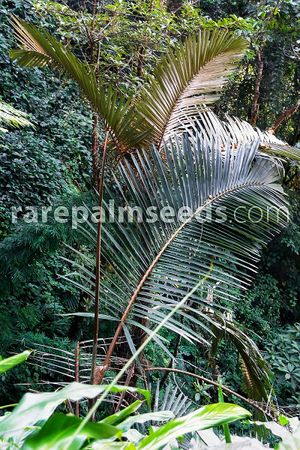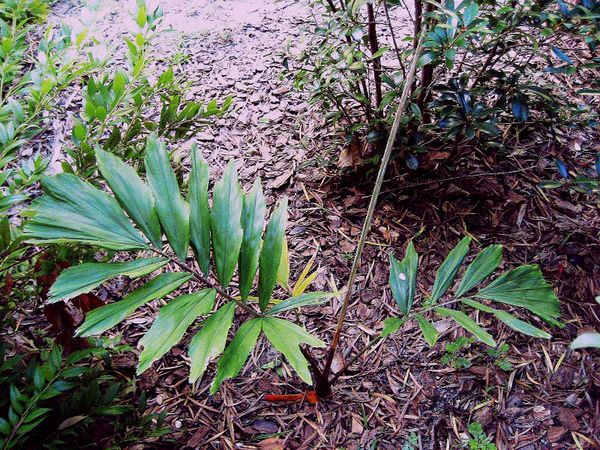Arenga micrantha
| Arenga (ah-REHN-gah) micrantha (mihk-KRAN-tah) | |||||||
|---|---|---|---|---|---|---|---|
 New Zealand. Photo by 'richnorm' | |||||||
| Scientific Classification | |||||||
| |||||||
| Synonyms | |||||||
|
| |||||||
| Native Continent | |||||||
|
| |||||||
| Morphology | |||||||
| |||||||
| Culture | |||||||
|
| |||||||
| Survivability index | |||||||
|
| |||||||
| Common names | |||||||
|
| |||||||
Contents
Habitat and Distribution
Arenga micrantha is found in East Himalaya, and Tibet. 2,000-2,150 m altitude in the Eastern Himalayan foothills (Tibet, Bhutan, India).Description
A strange-looking, multi-stemmed Arenga that grows to more than 6 m (20 ft) tall and carries elegant, large, flat, evenly pinnate leaves with brilliant white undersides. Growing up to an incredible 2000-2150 m (6500-7000 ft) above sea level, it regularly endures winter snow and HEAVY FROST in its habitat in the foothills of the eastern Himalayas, and is certainly the most cold hardy Arenga. A. micrantha was described as recently as 1988 from Tibet (would you have thought that any palm grows there?) and has now also been found to occur in Bhutan and N.E. India. It is extraordinary how this comparatively large palm could have remained undetected in an area that has been well and truly botanized for a hundred years, yet this is what has happened. Following the initial discovery of a small group of plants in N.E. India, it was found to be growing in several other locations, in some numbers, and is used by the locals for thatching and for the manufacture of brooms. A cool-growing palm, it is used to moist and mild conditions in summer, and cold, dryish conditions in winter. Rich soil and an occasional feed complete the picture of its requirements. (RPS.com)
Culture
USDA Zone 9, -6,5 °C This palm has only recently been rediscovered and cultivated and hardiness is not well documented yet.

Comments and Curiosities
This is a really special palm! A strange looking, multistemmed Arenga that grows to more than 6 m (20 ft.) tall and carries elegant, large, flat, evenly pinnate leaves with silvery white undersides. Growing up to an incredible 2000-2150 m (6500-7000 ft.) above sea level, it occasionally endures a light winter snow and freezes in its habitat in the foothills of the eastern Himalayas, and is certainly the most cool hardy in its genus. Arenga micrantha was described as recently as 1988 from Tibet (would you have thought that any palm grows there?) and has now also been found to occur in Bhutan and northeastern India. It is extraordinary how this comparatively large palm could have remained undetected in an area that has been well and truly botanized for a hundred years, yet this is what has happened. Following the initial discovery of a small group of plants in northeastern India, it was found to be growing in several other locations, in some numbers, and is used by the locals for thatching and for the manufacture of brooms. A cool-growing palm, it is best adapted to moist and mild or warm conditions in summer, and cold, dryish conditions in winter, however, in cultivation it has shown to be widely adaptable. Arenga micrantha has been introduced into horticulture through our efforts in the 1990s.
Conservation: Threatened Species.
Arenga is a genus of attractive pinnate palms from Southeast Asia. Arenga micrantha is a recent introduction into cultivation. It grows to more than 20 feet tall and carries elegant, large, flat, evenly pinnate leaves with brilliant white undersides. Found in Bhutan growing 6500-7000 ft above sea level! This is an area of foothills in the Eastern Himalayas known to encounter snow and heavy frost. This is the most cold-hardy Arenga. Arenga micrantha was described as recently as 1988 from Tibet. Arenga Micrantha has now also been found to occur in Bhutan and N.E. India. It is extraordinary how this comparatively large palm could have remained undetected in an area that has been well and truly botanized for a hundred years, yet this is what has happened. Following the initial discovery of a small group of plants in N.E. India, it was found to be growing in several other locations, in some numbers, and is used by the locals for thatching and for the manufacture of brooms. A cool-growing palm, it is used to moist and mild conditions during the summer and cold dry conditions in winter. Rich soil and an occasional feed complete the picture of its requirements. The growing habit is suckering which is an advantage for plants that might be damaged from extreme cold; since new plants will regenerate from a lower growing point. A most exciting addition to our climate! A good germination rate of 90% has been reported with very fast growing seedlings. This can possibly tolerate temperatures as low as 20 degrees F and may even tolerate as low as 16 degrees F. (Palm Society Northern California Chapter)
| read more |
|---|
|
This plant seems to love something about Florida, because it is a moderate grower here. It is easily discerned by the bronzish undersize to the pinnae. One specimen in Sarasota County has leaves approaching 10 feet tall with an even larger spear at about 7 years of age. There are reports of this plant taking temps into the upper teens with minor foliage damage - probably the most cold hardy Arenga. (cfkingfish) They do sucker but sparsely, not a thick clumper like A. engleri or A. tremula. They grow slow at first then speed up a bit when they get a few feet tall. This Tibetan species may end up being one of the most cold tolerant of all the palms, though it still has not been well tested. So far, however, it seems to do pretty well in most California climates in which it's been tried (not tried yet in Acton, California, though). It's a fairly slow growing palm with long, arching leaves and very long, parallel leaflets of dark green. With luck, this will end up being a gorgeous mature palm, but I have yet to see a mature one. (Geoff Stein) This is a really special palm! A strange looking, multistemmed Arenga that grows to more than 6 m (20 ft.) tall and carries elegant, large, flat, evenly pinnate leaves with silvery white undersides. Growing up to an incredible 2000-2150 m (6500-7000 ft.) above sea level, it occasionally endures a light winter snow and freezes in its habitat in the foothills of the eastern Himalayas, and is certainly the most cool hardy in its genus. Arenga micrantha was described as recently as 1988 from Tibet (would you have thought that any palm grows there?) and has now also been found to occur in Bhutan and northeastern India. It is extraordinary how this comparatively large palm could have remained undetected in an area that has been well and truly botanized for a hundred years, yet this is what has happened. Following the initial discovery of a small group of plants in northeastern India, it was found to be growing in several other locations, in some numbers, and is used by the locals for thatching and for the manufacture of brooms. A cool-growing palm, it is best adapted to moist and mild or warm conditions in summer, and cold, dryish conditions in winter, however, in cultivation it has shown to be widely adaptable. Arenga micrantha has been introduced into horticulture through our efforts in the 1990s. (RPS.com)
|
- IMAGE GALLERY
External Links
- Glossary of Palm Terms
- MODERN BOTANICAL LATIN
- "Just To Be Clear"
- Highland Palms
- In New Zealand Video by 'caryotagigas'
- https://www.youtube.com/watch?v=9F5-0rjC5K4
- https://www.agaveville.org/viewtopic.php?f=38&t=6483
References
Phonetic spelling of Latin names by edric.
Special thanks to Geoff Stein, (Palmbob) for his hundreds of photos.
Special thanks to Palmweb.org, Dr. John Dransfield, Dr. Bill Baker & team, for their volumes of information and photos.
Glossary of Palm Terms; Based on the glossary in Dransfield, J., N.W. Uhl, C.B. Asmussen-Lange, W.J. Baker, M.M. Harley & C.E. Lewis. 2008. Genera Palmarum - Evolution and Classification of the Palms. Royal Botanic Gardens, Kew. All images copyright of the artists and photographers (see images for credits).
Many Special Thanks to Ed Vaile for his long hours of tireless editing and numerous contributions.






































